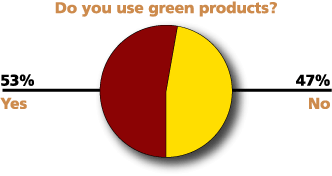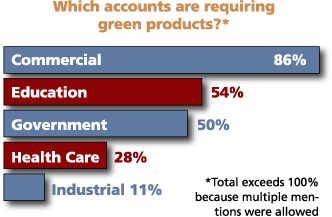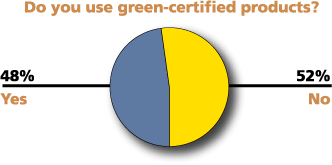A recent survey of building service contractors finds that green cleaning is breaking into the mainstream of cleaning practices, with a slight majority of BSCs using green products.
BSCs are becoming more familiar with green, and about half are using green products, according to a Contracting Profits survey conducted in November. A number of factors, including governmental regulations and concern for indoor and outdoor environments, continue to contribute to the popularity of green product usage.
Even though BSCs are getting the green message, it seems their customers may not be as concerned about those factors swaying BSCs.
A vast majority of those surveyed say their customers are not requiring the use of green products — especially certified ones.
MAJORITY RULES
Fifty-three percent of respondents are currently using green products.
That surprises Rafael Perez, owner of Mexfil Hotel and Building Services Inc., in Houston. Though his company is just on the cusp of adding green products to its cleaning arsenal, Perez assumed the percentage of BSCs using green products would be higher.
“It’s an awareness thing,” he says. “A lot of people don’t understand that there are a lot of benefits [to green cleaning].”
To Perez, more BSCs should be making the change from traditional cleaning products to green products. This switch to green cleaning does not need to be drastic. According to the survey, the most commonly used green products are multi-surface cleaners, restroom cleaners, microfiber, glass cleaners and carpet-care products.
SEEKING A SWITCH
Forty-seven percent of BSCs surveyed don’t use green products. Of that group, 35 percent say they plan to switch to green products in the near future. Some want to change because they feel green is the future of cleaning, while others cited customer demand. Company image was also a concern for a few respondents, and many — such as Kimberly Crane, owner/president of C&I Cleaning Service in Baton Rouge, La. — express their desire for a cleaner environment.
“Everybody’s going to it to be environmentally correct and safe,” Crane says.
ABH Services, Inc., in Winchester, Va., is on the verge of converting to green, but not before performing a test run at a few office buildings. President John Hess says he needs proof that green is the way to go before he fully invests in it.
“We don’t know. As far as we’re concerned, the verdict is still out,” Hess says.
If, after two or three months of green-cleaning at those facilities, Hess is convinced, the company will start converting more buildings.
Though he hasn’t experienced much customer demand yet, Perez says what customers want, they’ll get.
“I’ll change it to whatever they want me to change it to,” he says.
And trends indicate customers will increasingly want green cleaning options — but it’s going to take some time.
LOW DEMAND
While at least half of the companies surveyed have policies on using environmentally friendly cleaning products, very few customers are increasingly requesting the use of green cleaning products.
With 84 percent of respondents saying customers aren’t requiring the use of green products, and 89 percent saying green-certified products in particular are not required by customers, the survey suggests customers and the general public are unaware or unconvinced of the green cleaning movement.
It is therefore up to BSCs to educate themselves and customers on green cleaning and follow that by using products certified by third-party organizations.

C&I Cleaning Service has used green products for three years, but only for a few accounts that require it. Crane says the demand for green will grow exponentially in years to come, as concern for the environment comes to the forefront of cleaning.
With a growing number of cities and states mandating green cleaning in schools and government buildings, BSCs will need to learn more about green cleaning and begin to offer it, if they don’t already, to keep up with the trend.
“I think some of the bigger buildings, healthcare facilities and some of your bigger retails are getting more knowledge of it,” Crane says, and that smaller, more private entities will soon follow.
According to the survey, the small percentage of customers who do require green cleaning products to be used are mostly commercial office buildings. Following those accounts are government facilities and schools.
None of Hess’s customers have required the use of green products — but he anticipates they will, and has prepared by participating in educational seminars on green cleaning and microfiber.
“I do know from public opinion there’s more and more push in that direction, so if you’re going to be doing work with municipalities or schools and universities, you’re probably going to be moving toward green cleaning one direction or another, because of demand,” he says. “If demands hit, we’ll be ready.”
Demand for green by customers will grow, says Dick Dotts, president of Diversified Maintenance Services in Los Angeles. While customer-driven green cleaning is coming from the institutional, regulated sectors such as schools and government buildings, it doesn’t hurt BSCs to be proactive in implementing green cleaning programs despite low current demand.
BSCs can also foster a knowledge and appetite for green by educating their clients, Dotts says.
“I think the contractor kind of has an obligation to educate the client if you can,” he adds.
While the perceived higher cost for cleaning green may be a factor for customers, Perez also points to vendors, who, in his opinion, need to get behind green and push it to BSCs. From what he’s seen, green products are more effective and safer than traditional products when used properly. The hurdle, Perez says, seems to be education: of customers, of vendors and of BSCs. Those who are uneducated about green aren’t likely to care about converting.
“It’s one of those things — if it ain’t broke, don’t fix it,” Perez says.
It’s difficult to sell green to customers without backup, and a good partnership with a vendor or manufacturer’s representative often results in a win-win.
“I can’t go into a gunfight without any bullets and my bullets are my vendors backing me up and supporting this, because obviously, if I do something that my customer doesn’t want me to do, he’s going to find somebody else who can, and I certainly don’t want to be unemployed,” Perez says.
Crane agrees, saying she’s not a sales representative and it’s not her job to sell chemicals to customers, especially those who supply their own chemicals. As far as selling green, it’s up to the vendors to do their jobs educating BSCs and their customers on the benefits of converting. “
“
Your vendors are your most important part of changing your chemicals and I know every chemical change we’ve ever made, usually it’s the vendors coming out and teaching at least the supervisors and giving a demonstration,” Crane says.
Crane isn’t even sure her two top vendors offer green, and if they do, they haven’t told her about it.
As BSCs continue to convert to green cleaning products, they face the challenge of a customer base that, largely, is not yet driving demand for green-certified products. Many are confident, however, that the situation will improve in the months and years to come, mainstreaming green cleaning to a point all BSCs will need to offer it to stay competitive.

 The Down and Dirty on Cleaning in Virus Season
The Down and Dirty on Cleaning in Virus Season How Surfactant Use is Expanding in Commercial Cleaning
How Surfactant Use is Expanding in Commercial Cleaning Maximize Your Margins: Learn How to Automate Pricing and Track Rebates
Maximize Your Margins: Learn How to Automate Pricing and Track Rebates